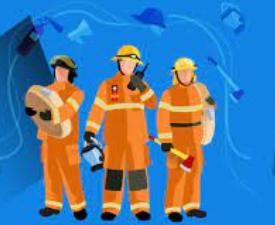Description
Course Name: Advance Diploma in Fire & Safety Management
Course Id: ADF&SM/Q1001.
Education Qualification: 12th Pass.
Duration: 370 Hrs.
How You will Get Diploma Certificate:
Step 1- Select your Course for Certification.
Step 2- Click on Enroll Now.
Step 3- Proceed to Enroll Now.
Step 4- Fill Your Billing Details and Proceed to Pay.
Step 5- You Will be Redirected to Payment Gateway, Pay Course and Exam Fee by Following Options.
Card(Debit/Credit), Wallet, Paytm, Net banking, UPI and Google pay.
Step 6- After Payment You will receive Study Material on your email id.
Step 7- After Completion of Course Study give Online Examination.
Step 8- After Online Examination you will get Diploma Certificate soft copy(Scan Copy) and Hard Copy(Original With Seal and Sign).
Step 9- After Certification you will receive Prospect Job Opportunities as per your Interest Area.
Online Examination Detail:
- Duration- 120 minutes.
- No. of Questions- 60. (Multiple Choice Questions).
- 10 Questions from each module, each carry 10 marks.
- Maximum Marks- 600, Passing Marks- 40%.
- There is no negative marking in this module.
| How Students will be Graded: | ||
| S.No. | Marks | Grade |
| 1 | 91-100 | O (Outstanding) |
| 2 | 81-90 | A (Excellent) |
| 3 | 71-80 | A (Very Good) |
| 4 | 61-70 | B (Good) |
| 5 | 51-60 | C (Average) |
| 6 | 41-50 | P (Pass) |
| 7 | 0-40 | F (Fail) |
Benefits of Certification:
- Government Authorized Assessment Agency Certification.
- Certificate Valid for Lifetime.
- Lifetime Verification of Certificate.
- Free Job Assistance as per your Interest Area.
Syllabus
Advance Diploma in Fire & Safety Management
Special Fire Hazards
special fire hazards, the 4 types of fire hazards, the five common fire hazards, the two categories of fire hazards, the meaning of special hazard, types of Hazards, SDS fire, fire tetrahedron, classes of fire, three stages of fire, identification of hazardous materials, fire prevention & protection, emergency evacuation, the main purpose of SDS.
Safety Management
the meaning of safety management, the five functions of Safety Management System, the four components of Safety Management System, the five types of safety, the five elements of safety, the three types of safety, the ten points of safety, twenty general safety rules, Accident causation models, Safety management as an organizational activity, Safety culture, National differences in safety culture, Preconditions for improving safety management, Integration of safety to other management activities.
Fire Protection Systems
Recognition of possible fire sources and emergency procedures in the event of a fire, the course also offers an in-depth study of fire investigation and the construction techniques for eliminating fires, History of fires, types of detecting devices and extinguishing agents and systems, construction techniques, and fire investigation, National Fire Protection Association and Occupational Safety and Health Administration standards, The measures needed to overcome behavioural problems and to ensure the safe evacuation of people in the event of fire, Assisting disabled people to escape,. Allocating responsibility and authority, Rehabilitation after an incident, Workplace inspections, Measuring and reporting, Developing and effective safety culture, Building an incident free workplace, Removing obstacles to safety.
Search and Rescue Techniques
The SAR System – Local, State, Federal plus Emergency Beacons, . ICS in SAR: The Organization and Structure, Anatomy of a SAR Mission, Legal Issues, and Public Expectations, . Survival Basics for SAR Responders, Dressing and Eating to Respond, The SAR Ready Pack – Minimum content and Option, Basic Survival Skills for Self and Taking Care of Others, Map & Compass – GPS and Supporting Computer Programs, Map and Compass Practical Field Exercises, Lost Person Behavior/Reflex Tasking for Team Leaders & Searchers, m Working Aircraft with Ground Resources in SAR.
Fire Safety Risk Assessment
The Regulatory Reform (Fire Safety) Order 2005, Fire hazards & risks, Plan Drawing, Brief look at drawing to scale, and how plans can be used to good effect, The process of fire risk assessment, Fire risk assessment recording and review procedures, The potential for pollution arising from fires, Measures to prevent and reduce fire pollution, Emergency Plans & Staff Training, Highly Flammables & LPG, Fire fighting equipment requirements, Fire resisting construction &compartmentation, Active fire safety for building protection: Sprinklers & Automatic roof vents, Fire risk assessment structure and layout, Means of escape principles: Basic requirements and what to look for, Fire signage: National requirements, Fire Alarms & fire detection: Basic components, and testing, Emergency lighting: When it is required, Basic components, and testing, Alternatives to emergency lighting.
Health Safety Environment
Occupational Health and Safety Specialist;Environmental Compliance Inspector, Identify accident prone areas and adopt methods for reducing accidents following safety precautions, Identify and apply safety policy in an industry and List out the duties and implement Safety Targets, Objectives, Standards, Practices and Performances, Identify marking and evaluate performance of explosives, Prepare profile with an appropriate accuracy as per safety precaution in workshop, Select the construction site for visit, plan and prepare the report.

